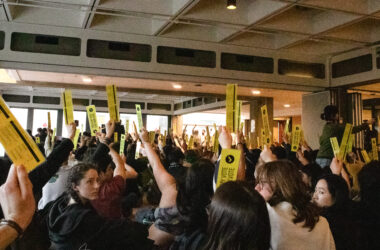She lived through the Spanish flu. He portrayed a suave MI6 agent on the big screen. She invented the windshield wiper. He remained a bon vivant into his ninth decade. She came to be known as “the people’s princess.” These are some of the subjects of the newspaper’s obituary pages.
Since the pandemic began, obituary writers have continued to do what they have always done: Provide captivating accounts of lost lives. To this end, COVID-19 has not upended the art of obituary writing; obituarists are less concerned with the granularity of human suffering and the cause of a person’s death, and more with artfully capturing the essence of a life.
However, COVID-19 has disrupted the obituary industry in other ways. As physical distancing restrictions continue to bar traditional mourning rituals, such as funerals and memorials, obituaries and death notices have emerged as communal spaces for mourners and the curious alike to navigate grief. In a public health crisis of such a magnitude, obituaries give readers the opportunity for a moment of humanity, exempt from abstract statistical projections and enable them to connect to the vibrant stories of strangers, with all their foibles and graces.
Faced with a plethora of life stories to report, obituary writers have had to implement their own form of triage. Danielle Adams, editor of obituaries at The Globe and Mail, described a new normal in the assignment of obituary coverage.
“COVID-19 has had an enormous effect on obituary writers and editors because of the sharp rise in the sheer number of notable people dying [….] The wave of deaths last spring/summer was absolutely overwhelming,” Adams wrote. “There were too many stories to tell [….] I think the stress of this situation has affected me quite a bit—as it is affecting everyone.”
There’s a fundamental difference between obituaries and daily updated death notices. Whereas obituaries generally feature the lives of public figures and individuals otherwise deemed notable, it is typically left to families and funeral homes to write death notices. The first wave of the pandemic marked a sharp increase in the number of death notices published in Canadian newspapers such as The Montreal Gazette and The Globe and Mail.For some it is in these swelling pages—online and in print—that the pandemic’s impact feels the most acute.
By remembering some of the lives lost to COVID-19, death notices and obituaries have assumed an increased resonance—by putting names and faces to the toll of the pandemic obituaries can blur the line between statistic and story.
Linnea Crowther, a senior writer for Legacy.com, a global leader in online memorials, has observed a sharp increase in obituaries through her ongoing project that tallies the number of U.S. obituaries in 2020 as compared to 2019.
“Watching the outbreaks travel around the U.S. through obituary publications has been sobering,” Crowther said. “In New York [C]ity, in April, there were 85 per cent more obituaries in April 2020 than in April 2019.”
The phenomenon is somewhat reminiscent of an earlier tragedy, the September 11 attacks, when Crowther was part of a team memorializing lives lost in the attack on the twin towers.
“[9/11] was a gruelling time for anyone in memorialization,” Crowther said. “In many ways, COVID-19 is similar for some people, especially in related businesses like funeral homes.”
Nevertheless, amid the pandemic, the fundamental mission of obituaries has survived unchanged, according to Crowther.
“I’m still committed to telling life stories,” Crowther said. “Regardless of what that cause of death is, I’m still writing that story.”
Susan MacKay, a freelance obituary writer for The Globe and Mail, voiced a similar sentiment, one that prioritizes the life of the subject above the circumstance of death.
“The focus is very much on […] what made [the person] extraordinary,” MacKay wrote.
The art of obituary writing entails a delicate exploration of someone’s life, a teasing out and careful mining of the hidden gems of their experiences, which are then distilled into a few hundreds, or even thousands, of words.
“I tell people that I want the reader to feel as if they knew the person,” McKay wrote. “There’s an obituarist’s joke that the editor asks the writer for a shorter obit to which the writer says ‘But I don’t have time to make it shorter.’”
Although the genre dates back to ancient Rome, where obituary notices were published in papyrus newspapers called Acta Diurna, obituaries rose to prominence in the mid-18th century. McGill history Professor Brian Cowan charted the rise of obituaries, which surfaced in 18th century British periodicals, tying their emergence to biographical writing.
“It’s in Gentleman’s Magazine in the 18th century where you begin to see regular death notices,” Cowan said. “That fits in with biography writing more generally, which has a long history. The obituary is a news item, but it’s also a mini-biography; almost a perfect encapsulation of those two genres coming together.”
Professor Cowan also tied the development of obituary writing to the expansion of celebrity culture.
“It fits with fame, too,” Cowan said. “There is this idea of who is worthy of an obituary—and who is not.”
The politics of whose death merits coverage and whose does not remains a fundamental challenge for obituary writing. Nick Serpell, the former editor of obituaries at the BBC, wrote the obituaries of hundreds of prominent figures, from Margaret Thatcher to David Bowie, during his 10-year term as editor. In an interview with The McGill Tribune, Serpell underscored the phenomenon of concurrent celebrity deaths, where famous individuals die in close proximity to one another, often with the death of one figure overshadowing the other. The death of Princess Diana, for example, by far eclipsed the coverage for Mother Teresa, who died less than a week later.
“There was no way Mother Teresa was going to get on a [U.K. network], because Princess Diana, who died [before Mother Teresa] was just massive,” Serpell said. “If you want to know my rules about getting good coverage when you die: Don’t die when someone more famous than you dies, and try to die on the weekend, because news is pretty sparse at the weekend. They don’t always follow those rules, unfortunately.”
This process of ranking deaths by newsworthiness continues to weigh heavily on the minds of obituarists, who must choose who gets featured in the obituary pages and who gets sidelined. This is especially true for local newspapers, which have emerged to provide a sanctuary for the coverage of lost lives during the pandemic, notable and obscure alike. Maureen O’Donnell, an obituary writer at the Chicago Sun Times, who has covered a wide range of notable lives since the pandemic, from Chicago TV news anchor Joel Daly to Italian deli matriarch Emilia Pontarelli discussed the increased demand for obituaries has had on her writing.
“Obituary writers are getting a lot more requests to write obituaries due to the pandemic,” O’Donnell said.“You can’t write about everyone who died, but, to many, that one obituary can be universal.”
If there is a common sentiment that unifies obituarists in their craft, it may be the honour of providing a space independent of geography and location, where people can mourn and celebrate the dead, whose stories will remain committed to prose.
“It’s such a gift to be able to tell these stories,” O’Donnell said. “When you can’t be at the funeral home or at the graveside, at least you can read the obituary.”









